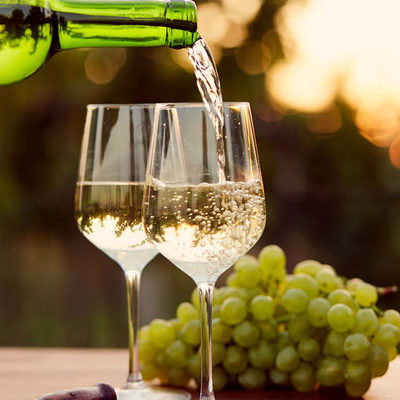
White Wine
What is White Wine?
White wine is a type of wine made from white grapes fermented without the skin. Brewers ferment white grape juice using yeast which consumes the sugar in the juice and creates alcohol. Many varieties of this wine can be made using various grapes combined with different types of yeast.
The top 10 most popular types of white wine are:
- Chardonnay 6. Gewurztraminer
- Sauvignon Blanc 7. Viognier
- Riesling 8. Chenin Blanc
- Pinot Gris 9. Gruner Veltliner
- Semillon 10. Torrontes
The world’s largest producer of wine is Italy, followed by France and Spain. In 2018, the worldwide wine market produced 292.3 million hectolitres of this alcoholic beverage.
Origin of white wine
Fermented drinks made from fruit, rice, and honey date back to 7,000 BC – 6,500 BC in ancient China. In the oldest known winery, located in Armenia, ancient winemaking vessels were discovered from 4,100 BC. Egyptians also consumed wine as evidence shows it was stored in the tombs of pharaohs. Much later, Phoenecian traders brought wine and grapevines to the Mediterranean, where they flourished.
The Romans are often credited with turning wine into an industry in order to produce higher quality beverages between 3,000 BC – 2,000 BC. There are even stone tablets from Hattusa during this period that reference white wine, which indicates that it was important in the culture of the time. Scientists believe that white grapes likely evolved out of a genetic mutation over 3,000 years ago. Although there are many different types of white wine, today they all originate from around 20 different types of grape. Nowadays, Europe is the biggest producer of white wine in the world, although some American states also produce a substantial amount of wine.
Function
This wine can be used in cooking to add sweetness and flavor that cuts through rich fats such as butter. Some common uses for this are sauces and marinades. As it is a liquid, it’s important to bear in mind that wine will evaporate and leave behind only its flavor. Therefore, when cooking with wine, approach the process with a less is more attitude. Wine should also have time to simmer, so the dish can fully absorb its flavor.
Nutrition
This wine lacks some of the health benefits of red wine since it is fermented without the grape skin. A 5 fl oz glass of wine can contain 129 calories and plenty of antioxidants and phenolic compounds that help the body fight free radicals. As always, alcoholic drinks should be consumed responsibly and in moderation to avoid weight gain, liver problems, and other health issues.
Commercial production
California state produces most of the wine made in the United States. Commercially producing white wine begins with cultivating the right grapes. Grapes are picked before being placed inside of a crusher, then a machine known as a presser that squeezes out their juice. The wine juice is separated from the skins, then filtered and stored in tanks where winemakers add yeast to begin fermentation. Once it is fermented, it is stored for a few months after which it is filtered, bottled, and kept in a cool place until sold.
Use
Aging wine can give it more depth and flavor, although some white wines age differently. That’s why storing wine correctly will ensure that it lasts long enough to be fully enjoyed. White wines should always be kept away from heat and stored at a consistently cool temperature between 45° F to 65° F (7.2 to 18.3oC). Also, wines must be stored away from light and shouldn’t undergo any big changes in temperature, as this can affect their quality. The ideal humidity level for white wine is 70%, which will keep corks from drying out and the wine from aging too fast.
White wine recipes
This wine can be consumed as a drink or added to dishes to brighten their flavor. Here are some popular recipes:
- Easy White Sangria
- Parmesan Risotto
- Mussels in wine sauce
- Creamy chicken in wine sauce
- Lemon and wine marinade
FDA Regulation
The Food & Drug Administration regulates the bottling, packaging, and labeling of wine. However, it is the Alcohol, Tobacco Tax, and Trade Bureau that is in charge of inspecting and enforcing these regulations. The TTB defines white wine as “wine produced by the normal alcoholic fermentation of the juice of sound, ripe grapes.” This organization also has definitions for other types of this wine, including Bordeaux Blanc among others. The FDA has regulations for dealcoholized wine which dictates the exact protocol for labeling.
References
“Wine: Beverage.” Truefoodfact.com, True Food Fact, 22 June 2020, truefoodfact.com/beverage/wine/.
Shapira, J.A. “The White Wine Primer.” Gentlemansgazette.com, Gentleman’s Gazette, 10 May 2018, www.gentlemansgazette.com/white-wine-primer/.
Pincock, Stephen. “First White Wine Was a Happy Accident.” Abc.net.au, Australian Broadcasting Corporation, 1 Mar. 2007, www.abc.net.au/science/articles/2007/03/01/1858180.htm.
“The Beverage Alcohol Manual.” Ttb.gov, Department of the Treasury Alcohol, Tobacco Tax & Trade Bureau, 1 Aug. 2018, www.ttb.gov/images/pdfs/wine_bam/complete-wine-beverage-alcohol-manual.pdf.
